THESIS ABSTRACT
The critical global issue of sustainability and circular economies is a core issue that demands attention in the construction industry. A specific environmental concern in this regard is the production and utilisation of cement. This process is one that has significantly detrimental effects on the environment due to the large volumes of carbon dioxide emissions released during the production process. In response to this environmental issue, there has been extensive recent research on materials that can replace the cement in concrete. These materials are known as supplementary cementitious materials (SCM’s) or pozzolans and are typically either industrial or agricultural by-products.
Sugarcane bagasse ash (SCBA) is one such waste byproduct which has been proven to have pozzolanic potential. South Africa has optimal sugarcane growth conditions and is the largest sugarcane producer on the African continent. The efficient and effective use of this byproduct of sugarcane production in cement production thus offers the potential for playing a significant role in decreasing the negative and environmentally damaging side-effects of cement usage in the construction industry.
In addition, one of the most critical social and economic issues facing South Africa is the housing crisis in the country. One quarter of the citizens live in informal settlements with no access to adequate housing.
This thesis explores a potential way to address these two major environmental and socio-economic issues in South Africa by looking at the possibility of seeking a solution which addresses both.
Therefore, this thesis aims to critically analyze and explore the social, ecological and architectural dimensions of the utilization of sugarcane waste as a pozzolan in order to address both the environmental impacts of the construction industry as well as the urgent need for adequate housing in South Africa. Attention will also be given to the relative benefits and disadvantages of SCBA concrete over alternative pozzolans.
THE CONSTRUCTION INDUSTRY
The construction industry is responsible for 7% of the global carbon dioxide emissions. This is specifically due to the cement production process shown below.

Therefore, there has been significant research into pozzolans which replace a portion of cement and thus lowers the carbon dioxide emissions. A pozzolan can chemically react with cement and form cementitious bonds. Specifically the silica content of the pozzolan reacts with the calcium hydroxide of the cement and added water to produce a calcium silicate hydrate gel which binds the materials together.
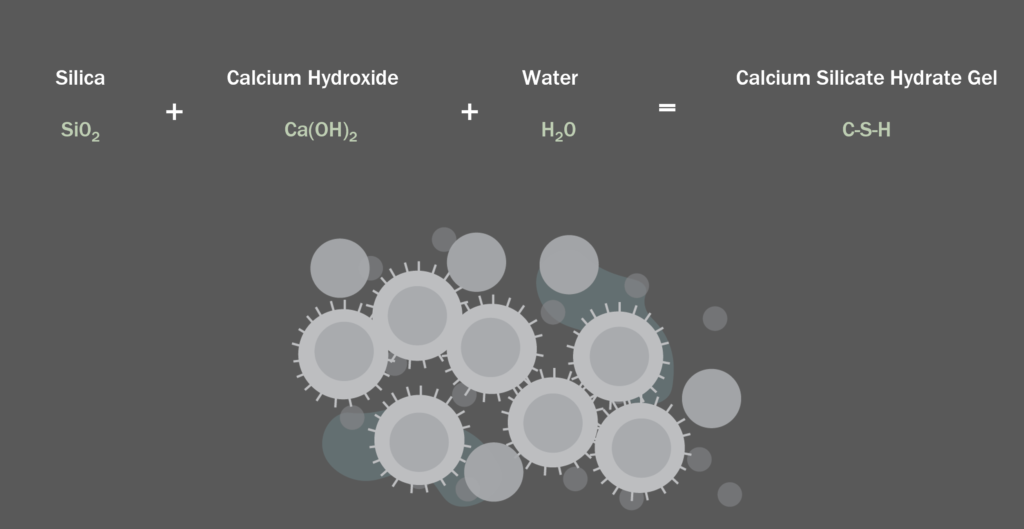
SUGARCANE BAGASSE ASH
A specific pozzolan which has proven to have pozzolanic ability is sugarcane bagasse ash. Looking at the chemical composition of this material, it is clear that the silica content is high which therefore contributes to this pozzolanic ability.

The minerology of the silica is also important and effects the ability to react with cement. Specifically silica with a crystalline structure will act as an inert to pozzolanic activity where an amorphous structure increases this ability.

There is however a high crystalline minerology found in bagasse ash due to two reasons. The first being quartz sand mixed with the sugarcane during the harvesting process and the second due to the uncontrolled burning of the sugarcane which converts the silica into a crystalline state. There are however ways to decrease the impact of crystalline silica, namely selective grinding and a further calcination process.

SOUTH AFRICAN SUGARCANE INDUSTRY
A specific country where sugarcane is grown, is South Africa. The country has almost 23000 growers who produces on average 20 million tons of sugarcane annually. This is also the crop which has the highest production volume in the country.
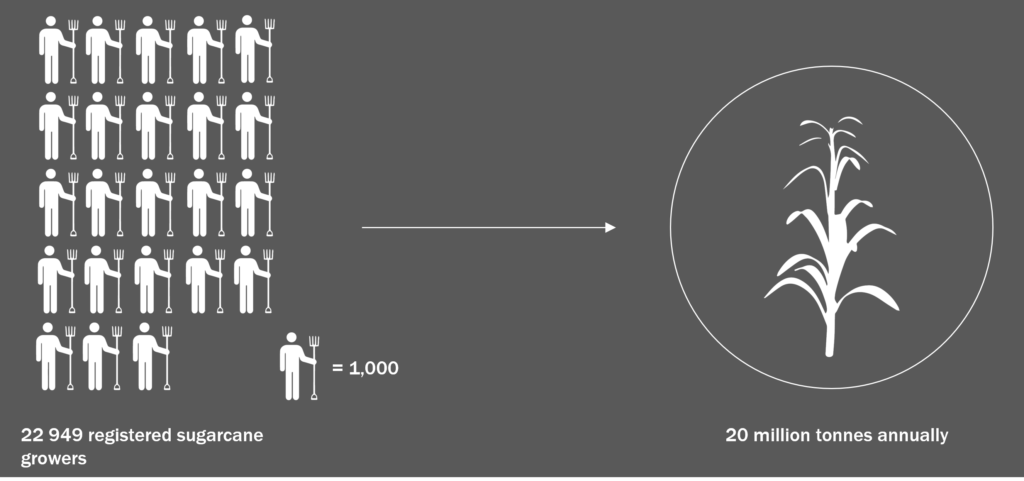
Looking at the production process of the sugarcane, the crop is milled to extract the juices and bagasse is produced as a by- product. This waste is then burnt in boilers which generates electricity to fuel their mills. Additionally, this boiler process produces the pozzolanic material, known as bagasse ash.

Currently the surplus ash is mainly linked to animal feed stock productions or dumped onto roads as the industry doesn’t have any other use for it. Therefore, an exciting opportunity arises to use this waste material in the construction industry where the ash can be turned into a valuable and desired material due to its pozzolanic ability.

ANALYSIS OF POZZOLANS IN SOUTH AFRICA
Fly Ash and Slag are two industrial by products commonly being used as pozzolans in South Africa. Comparing the embodied carbon of these pozzolans to that of sugarcane bagasse ash, it is clear that the bagasse ash does have a higher embodied carbon. However comparing it to that of cement, it is significantly lower and therefore would still drastically reduce the embodied carbon of concrete if a portion of the cement is replaced with bagasse ash.

Looking at the trends in the particular industries of the pozzolans, its clear that both the steel and coal industries are in a decline where the sugarcane industry shows an incline. Specifically, the coal plants are deliberately being shut down in the next coming years due to the environmental impacts. Contrastingly, even though the trend in the steel industry over the past 5 years shows a decline, it is still expected to remain a strategic industry as it represents 1.5% of the country´s GDP. However, slag is majority used for road construction due to its specific properties and therefore it is not commonly used in housing construction.
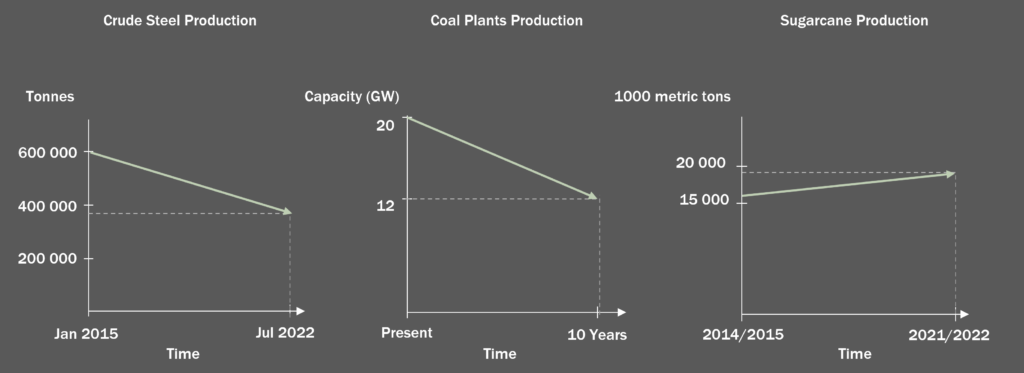
HOUSING SITUATION IN SOUTH AFRICA
A quarter of the population of South Africa live in informal settlements, Specifically this refers to living conditions which may experience no access to a piped water supply, electricity, poor waste management and sanitation. Additionally the houses are poorly constructed and use building materials which are highly flammable contributing to frequent fires which rapidly spreading throughout the settlements.
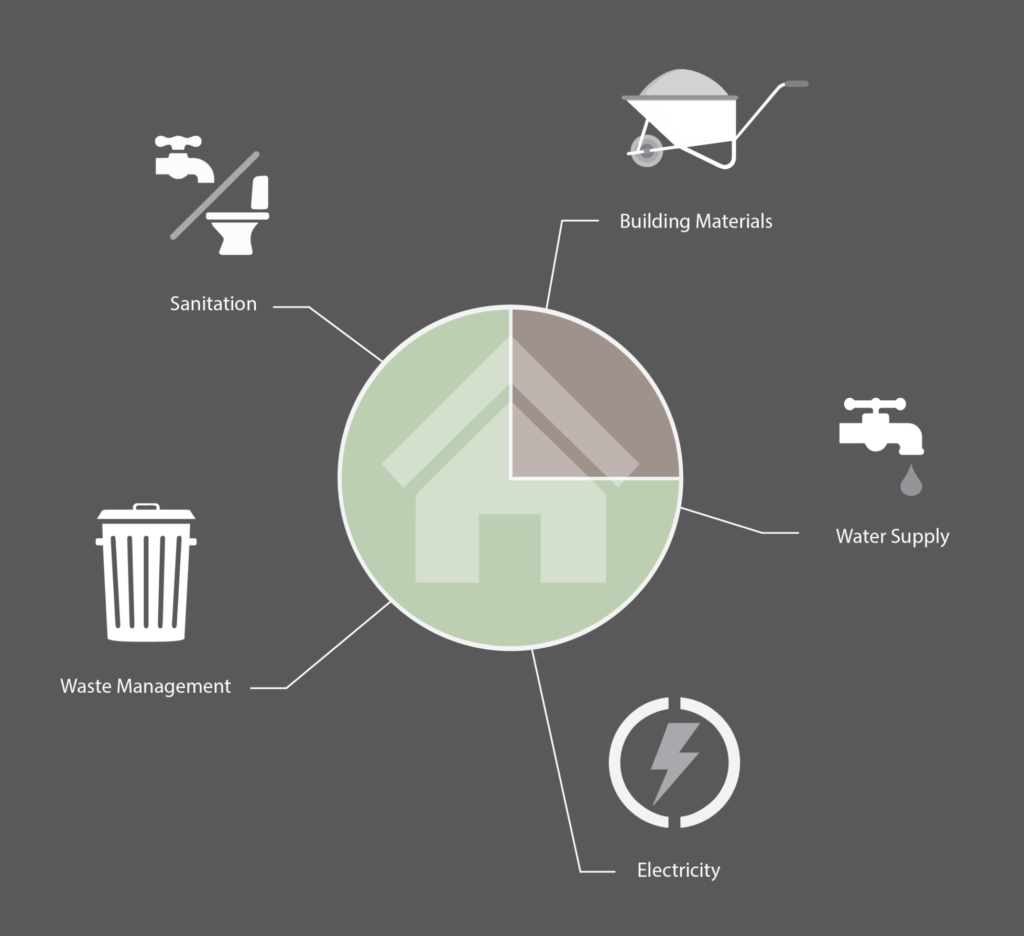
LOCATION ANALYSIS
Analyzing the different industry locations, a specific area drew interest which contained a number of sugarcane mills, cement plants and two of the largest informal settlements.

This area was further narrowed down to the indicated area containing one cement plant, one sugarcane mill and the two settlements.
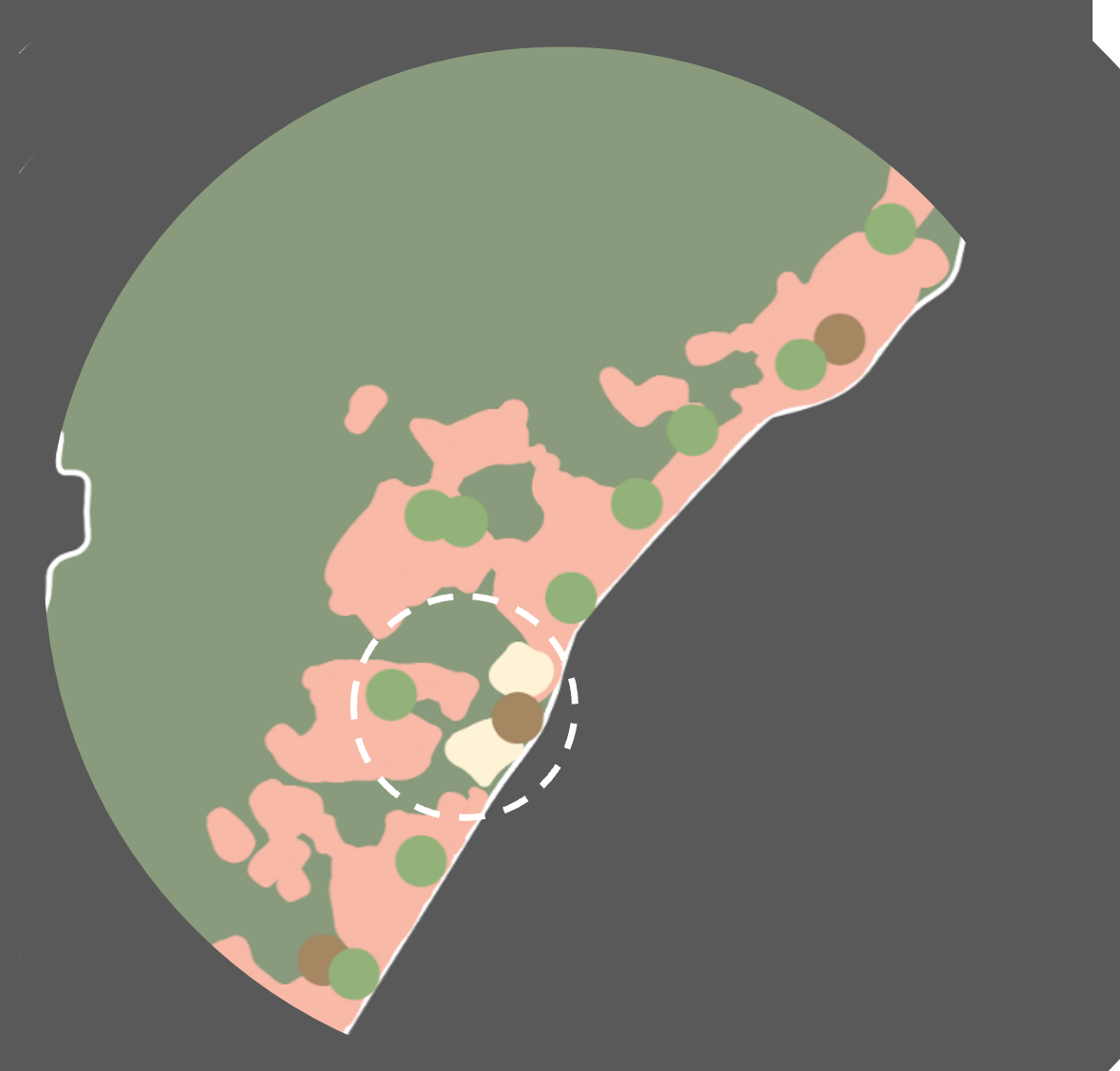
Satellite imagery of this specific area was generated which allowed a closer analysis of how the land geologies differ between the locations of the mill, plant and settlements.

In order to analyze more deeply, and extract different information the naked eye can not necessarily make, Landsat 8 OLI data for this specific area of interest was downloaded. This data produces 9 spectral bands of different wavelengths and by arranging these bands in different ways, one can extract unique information.
The band combination 4-3-2 was first generated, which reproduces near to what the eye sees.
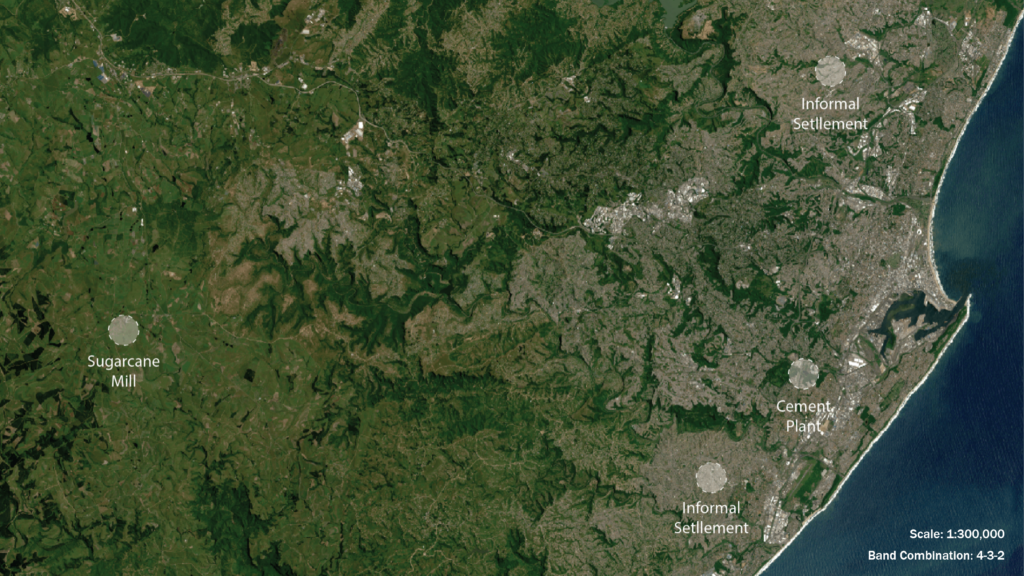
The 5-4-3 band combination was then generated which indicates vegetation with better wellbeing as a darker red.

The band combination of 6-5-4 is commonly used for an agricultural analysis, as the healthier vegetation will appear darker green.
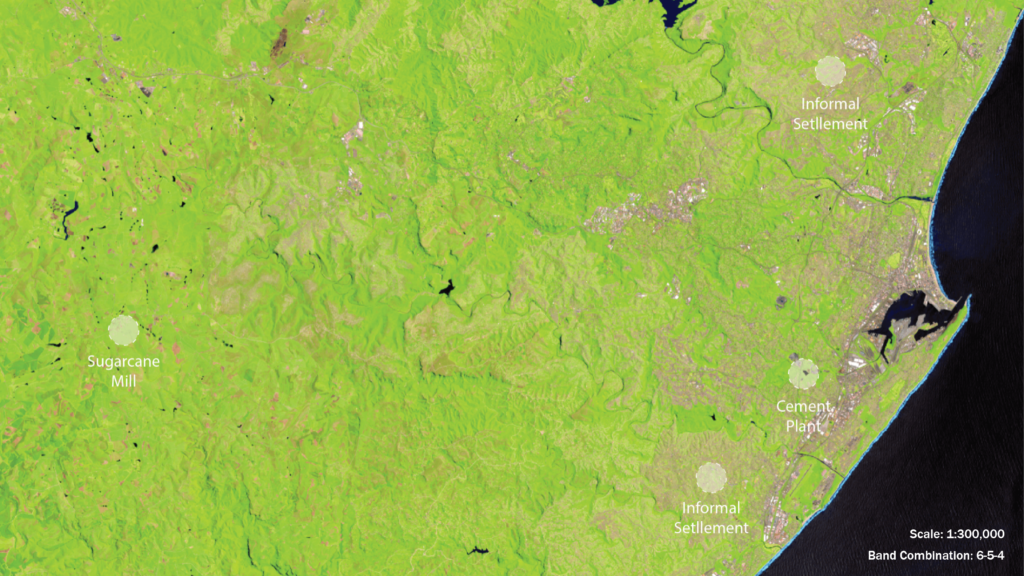
Finally, an ¨normalized difference vegetation index¨ analysis was carried out which shows a spectrum from red to green. Where red indicates no vegetation and green shows high amounts of vegetation.

CONCLUSIONS
Therefore the research done up to this point, clearly shows that there is an importance and value in carrying out this research.
My next steps will include determining the most suitable location for the usage of this specific pozzolan as well as exploring which aspect of the housing crisis will be most beneficially addressed by the usage of this sugarcane material.
These particular steps are vital in determining the direction which needs to be explored in order to develop the most suitable design solution for this specific situation.
In the final part of this thesis, I would like to take my research from a specific to global applicability, creating steps which can be taken in order to determine the most appropriate pozzolan to be used in different locations and scales, depending on the resources and issues being faced in that specific region.
CREDITS
Moving Concrete to Green Pastures is a project of IAAC, Institute for Advanced Architecture of Catalonia developed at the Master in Advanced Architecture in 2022/2023 by student: Emily Rackstraw and faculty: Marco Poletto

